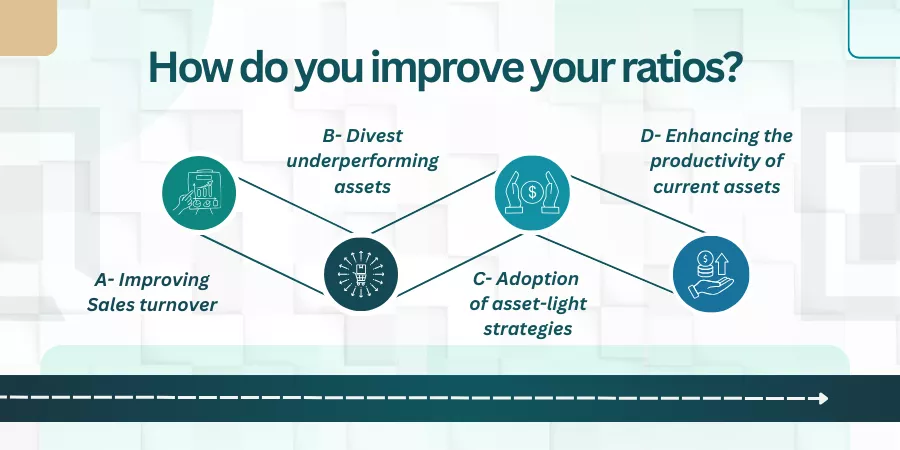Introduction
Doing your research correctly is something you surely cannot miss out on. This is especially true if you are a novice or an amateur investor who has just forayed into the world of investments.
What Is A Good Investment Turnover Ratio? Well, this is a ratio that determines how much return you obtain from your Investment portfolio. You get a good investment return if your allocated assets do well in the market.
Or, you can look at product-issuing firms that provide a modest rate of returns, as promised in your investment offer letter.
On this parlance, let us explore detailed insights pertaining to the same. Helping you go further down the line:
What Is An Investment Turnover Ratio: Meaning And Conceptualization Explained
An Investment turnover ratio refers to a type of ratio that measures how efficiently an enterprise firm utilizes its assets or investments to generate sales or revenue figures for the company. On a commonly held parlance, this is a ratio that evaluates the managerial efficiency with which a company performs on a broader note.
In a nutshell, it is the Investment turnover ratio that is a financial assessment for determining a company’s top management performance over capital efficiency.
This is how an Investment Turnover Ratio is calculated:
Image Courtesy: https://www.googleimages.com/
How does an investment turnover ratio vary between different scenarios in the market?
An Investment turnover ratio can vary between industries. Let us have a rundown of the variation scenarios:
A- Capital Intensive Industry
For a capital-intensive enterprise, an investment turnover ratio is calculated when you divide the Net Sales turnover of the enterprise by the Net Operating assets of the company. Here is the formula that pertains to the same:
Industry: Investment Ratio:- Net Sales÷Net Operating Assets
B- For an Investment Portfolio
For an investment portfolio, the investment turnover ratio refers to the frequency with which the shares or stocks of the company are bought/ sold.
What Is A Good Investment Turnover Ratio: Insights Explained Across Industries

No one size fits it all. Therefore, a good investment turnover ratio differs from one type of industry to another. Let us have a rundown on the same:
A: Retail Industry
The retail industry encompasses that types of business units and retail shops that sell goods and services to customers. The retail industry sells manufactured goods as well as utility services to their end-consumers.
For instance, you have Walmart, which sells high-end fast-moving consumer goods across a chain of outlets across the US. This is a classic example of a retail brand.
A good investment turnover ratio for the retail industry ranges between 2.5 to 4. The high turnover attributes to a rapid movement of stocks and inventory over the asset turnover.
B: Manufacturing Industry
A Manufacturing industry refers to a gamut of labor-intensive industries that manufacture products from raw materials. The raw materials are procured from distributors and suppliers.
These raw materials are processed through heavy-duty machinery to convert them into finished products.
For instance, the Ford Manufacturing Unit, which has its original headquarters in Germany, is an example of a manufacturing brand for cars and heavy-duty automobiles.
An ideal investment turnover for a manufacturing setup ranges anywhere between 1.0- 2.0. Here, the investment turnover ratio is a moderate one owing to the heavier degree of capital investment.
C: Utilities
The Utility industry refers to the set of business units that manufacture utility products that consumers use on a day-to-day basis. Manufacturing set ups that create tooth brushes, tooth pastes, cooking items, hot pressed oils and deodorant shampoos are examples of brands that encompass the utility industry.
For instance, you have Unilever that sells soaps, shampoos or detergents to consumers across the world. This is a classic example of a utility brand.
An ideal investment turnover ratio for a utility industry must be less than 1. This is due to the higher degree of capital investment.
D: Tech/ Software Industry
Tech Industry refers to a gamut of enterprises that provide software and consulting services to individuals and companies.
For a tech firm, the investment turnover ratio ranges from 2.0 to 3.5. The higher ratio is on account of expecting a higher efficiency on a lower asset base.
Apple Inc. and Wipro are renowned software companies that are known for delivering high-end software consulting services to their clients.
E: Real Estate Industry
The real estate industry relates to companies that produce commercial as well as residential properties. The industry thrives on producing immovable assets that generate a slower turnover. The industry investment ratio is <1.
As a thumb rule, you must understand one important thing. The higher the Investment Ratio, the better the utilization of the industry’s assets over its capital investment.
However, if the investment turnover ratio for an enterprise is excessively high, then it reflects underutilization of long-term assets. Here, you look at idle assets that are no longer in use. DLF Properties is a renowned real estate brand to look at.
How do you interpret investment turnover ratios?
Here are three scenarios that help investors determine how their companies are performing. Using investment turnover ratios, let us figure out how we can deduce the same:
A- High Investment Turnover Ratios
When a manufacturing or a service enterprise constantly generates high investment turnover ratios, you can rest assured that this company effectively utilizes its assets and investment portfolios to generate higher sales turnover. This index, therefore, indicates a robust performance on the operational front indeed. You can also find slightly lower investment turnover ratios for low capital-intensive utility firms or digital companies.
B- Is the Investment turnover ratio way too high?
Sometimes, the investment turnover ratio of enterprises can be way too high over the permissible limits. In this case, you do not find it as a green signal for you to invest in these companies.
A greater investment turnover ratio implies that the company is not utilizing its resources effectively. It is not reinvesting enough profits into fixed assets and R&D initiatives. The enterprise owners are focusing on short-term profits over long-term growth, and this is not a conducive industry for you to invest in.
C- Low Investment Turnover Ratio
When an enterprise suffers poor investment turnover ratios year after year, it indicates poor operational performance at poorer efficiency levels. This happens due to the underutilization of movable and immovable business assets.
A low investment turnover ratio may be acceptable for highly capital-intensive and capital-regulated industries like power generation and telecom.
What are the trends that imply rising or falling investment turnover ratios for manufacturing companies and service industries?
Here is a rundown of a rising investment turnover ratio over a falling one. Let us have a rundown of scenarios that pertain to the same:
A: Rising Trend turnover ratio
When you find rising turnover ratios following a trend-setting pattern, then the enterprises you are looking at, the enterprises are good to go as their operational efficiency keeps improving over time. Lightweight asset models also reveal improved investment turnover ratios.
B: A Falling trend turnover ratio
When you find falling turnover ratios as a trend-setting pattern, then the enterprises you are looking at are not good to go. These enterprises might have excessive capital tied up in fixed assets with a low sales turnover. The trends might also signal a sudden spurt of high-rise investments without a proportional increase in sales turnover.
How do you improve your ratios?

Here are ways and means by which you can improve the investment turnover ratios of your enterprises. Let us have an overview of how this can be done:
A- Improving Sales turnover
You must bring in new sales turnover initiatives without increasing the capital requirement of the industry. You can improve the online presence of your brand by implementing the latest digital marketing initiatives for your firm. This can elevate the online presence of your firm. You can also include visual ads on Google AdSense or Facebook to help connect with the masses.
B- Divest underperforming assets
You can replace under-performing assets with better-performing ones. For instance, a machine that has been running for 10 years can be replaced with a brand new one with better capacities. Or, you can replace outdated or obsolete software with the latest one. You must account for the depreciation of worn-out assets and replace them with newer ones. This way, you keep stashing out underperforming assets or digital ware from your manufacturing hubs or service-oriented firms.
C- Adoption of asset-light strategies
You can apply asset-light strategies to your industry model. This can elevate the brand presence and improve the capital utilization of your enterprise or factory. Asset-light strategies include outsourcing, leasing, and M&A (Mergers and Acquisitions). These initiatives can improve the managerial and operational efficiency of the brand while also bringing fresh capital to cope with your working requirements of the e-commerce or physical hubs you have on hand.
D- Enhancing the productivity of current assets
You can enhance the overall productivity of current assets. For instance, machinery can be serviced, and machine parts can be oiled from time to time. For a software firm, you can add enhanced plugins to improve the working efficiency of the existing software. You can look for trendy ways and means to enhance the productivity of your current assets so that they improve your sales turnover and elevate the credibility of your brand.
The Bottom Line
You must invest in firms that are doing well. This is in terms of managerial expertise or operational efficiency. When you invest in these firms, you get enhanced returns on stocks or buyout shares you procure from these enterprises. You must read the offer documents carefully before investing. What are your thoughts on this? Do mention it in the comments below!
Frequently Asked Questions or FAQs
Can you buy mutual funds to improve your portfolio turnover?
Answer: Mutual funds comprise indexed funds like S&P 500, or you have a basket of high-paying stocks or shares and these are bundled products offered to investors on the whole. Mutual funds are observed by fund managers who indulge buying and selling investment derivatives from stock exchange corporations and investment banks.
How do you differentiate a low turnover from a higher turnover rate?
Answer: A lower turnover ratio reveals lower sales turnover of a firm while the capital assets of the firm remain constant. A higher turnover ratio reveals better managerial efficiency and operational performance of the firm. Expense ratio further reveals how the expenses are utilized over the given capital investments. The investment turnover ratio indicates the overall investment objective of your investment portfolio.






